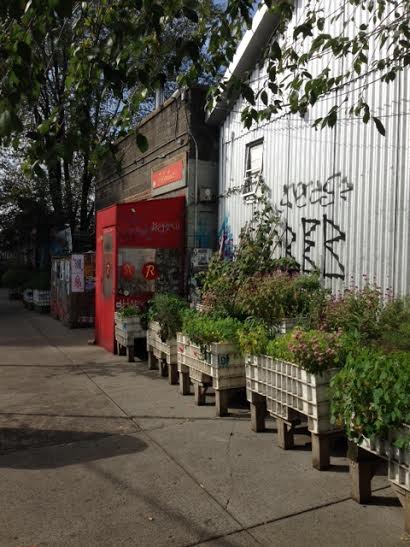Planters overflowing with herbs and flowers line Roberta’s dingy brick exterior. On the back patio, customers wolf down fresh pizza among the greenery. Gardener Melissa Metrick strolls among them, checking on the plants. Roberta’s, located in Bushwick, N.Y., is just one of the many eateries that grows its own produce.
The practice of restaurants serving food grown onsite is one element of urban farming, which has had its most recent boom in popularity in the last five years. It is loosely defined as the practice of growing food in urban spaces.
“That can mean anything,” New York University professor Amy Bentley said. It is “using kind of these hidden spaces, or in-between spaces, that may be dead space, may be unused space, may be just grass, and then trying to produce food.”
In New York, these unused spaces can be difficult to find. Spaces suitable for community gardens often compete with an interest in building affordable housing, said Carlos Martinez, deputy director of community gardening program GreenThumb.
GreenThumb, a program under the jurisdiction of the city’s Department of Parks and Recreation, works with different agencies to make city-owned or abandoned lots into community gardens. It oversees more than 600 gardens in New York, and has an additional 500 in schools. Martinez has seen that number increase, especially in schools.
“There is a high need of teachers and schools to provide food access,” Martinez said in a phone interview.
NYU Steinhardt’s Food Studies Department meets that need with its garden, located between 110 Silver Towers and Houston Street. The garden is an extension of Steinhardt’s urban agriculture class, which has been part of its curriculum for four years.
“Its basis is teaching students how to grow food within the city,” Urban Agriculture professor Metrick, said.
Creating ideal growing conditions in New York entails bringing in outside soil. GreenThumb does this and uses raised beds for its gardens.
The biggest concern among gardeners is the permanency of their gardens, as some open under a one-year license agreement, according to GreenThumb Project and Design Coordinator Brittany Quale.
Steinhardt’s garden faces this same problem. Currently closed because of construction on Silver Towers, it may also need to be relocated. Silver Towers is a landmarked building, so everything on its property requires approval by the NYC Landmarks Preservation Commission.
“The garden needs landmark approval – permanent landmark approval,” Bentley said, who has been with the Food Studies Department for 20 years. “We got temporary landmark approval.”
The exception to this problem is a garden created on a lot owned by the Department of Parks and Recreation, which has immunity from use by other city agencies.
“It’s a garden for life, a public space for life,” Martinez said.
The premise of GreenThumb is the value on these public spaces and the hope that people will join others to grow their own food. This saves gas, provides fresher food and creates a diversity in food production, according to Bentley, something that Roberta’s accomplishes.
Even big corporations are getting on board. JetBlue recently launched a farm in partnership with GrowNYC, a nonprofit that promotes and educates about environment sustainability, at John F. Kennedy International Airport. The 24,000-square-foot farm’s biggest crop is blue potatoes for JetBlue’s Terra Blues potato chips. Herbs and other produce like arugula, kale and beets, are growing in smaller quantities and will both be used by restaurants in Terminal 5 and donated to food banks.
JetBlue approached GrowNYC about the project, according to GrowNYC member and farm manager Katrina Ceguera.
“I think the fact that a large company like JetBlue is willing and excited to hop into the urban agriculture movement is very exciting and very telling,” Ceguera said in an email. “It definitely helps to legitimize and recognize urban farming, and to get people to be more conscious of where their food comes from and the labor that goes into it.”

